Marketing Analysis of Woolworths: Strengths, Weaknesses, and Strategy
VerifiedAdded on 2020/02/24
|13
|3165
|43
Report
AI Summary
This report provides a detailed marketing analysis of Woolworths, a major Australian supermarket chain. It examines the company's growth and profitability, including its 'Lean Retail' model and financial performance. The report conducts a PESTEL analysis to assess the macro environment and explores Woolworths' market segments, including geographic, demographic, psychographic, and behavioral segmentation strategies. It identifies the company's target markets and analyzes the nature of competition in the retail industry, comparing Woolworths' strengths and weaknesses. The report concludes with a positioning map and strategic recommendations for the company's future.
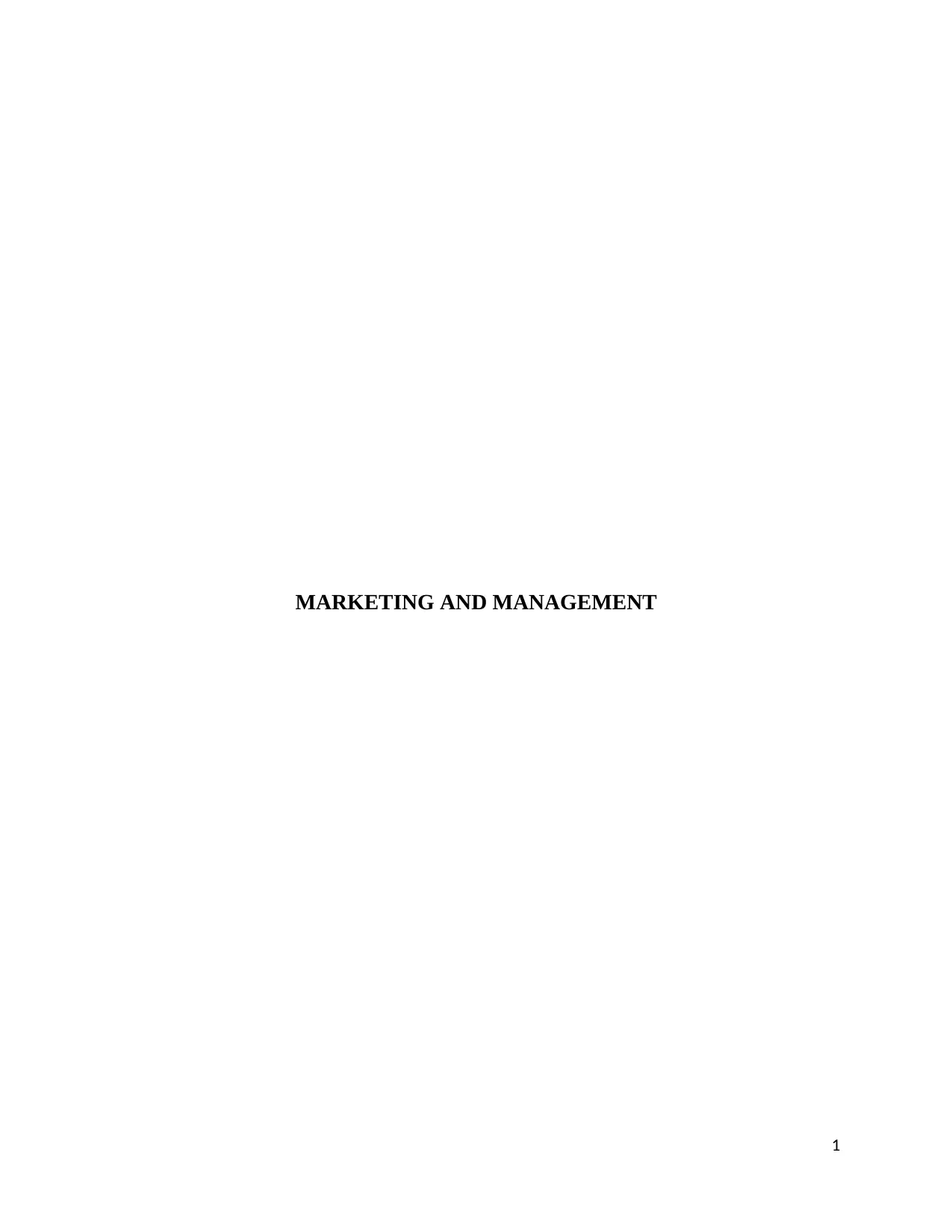
MARKETING AND MANAGEMENT
1
1
Paraphrase This Document
Need a fresh take? Get an instant paraphrase of this document with our AI Paraphraser
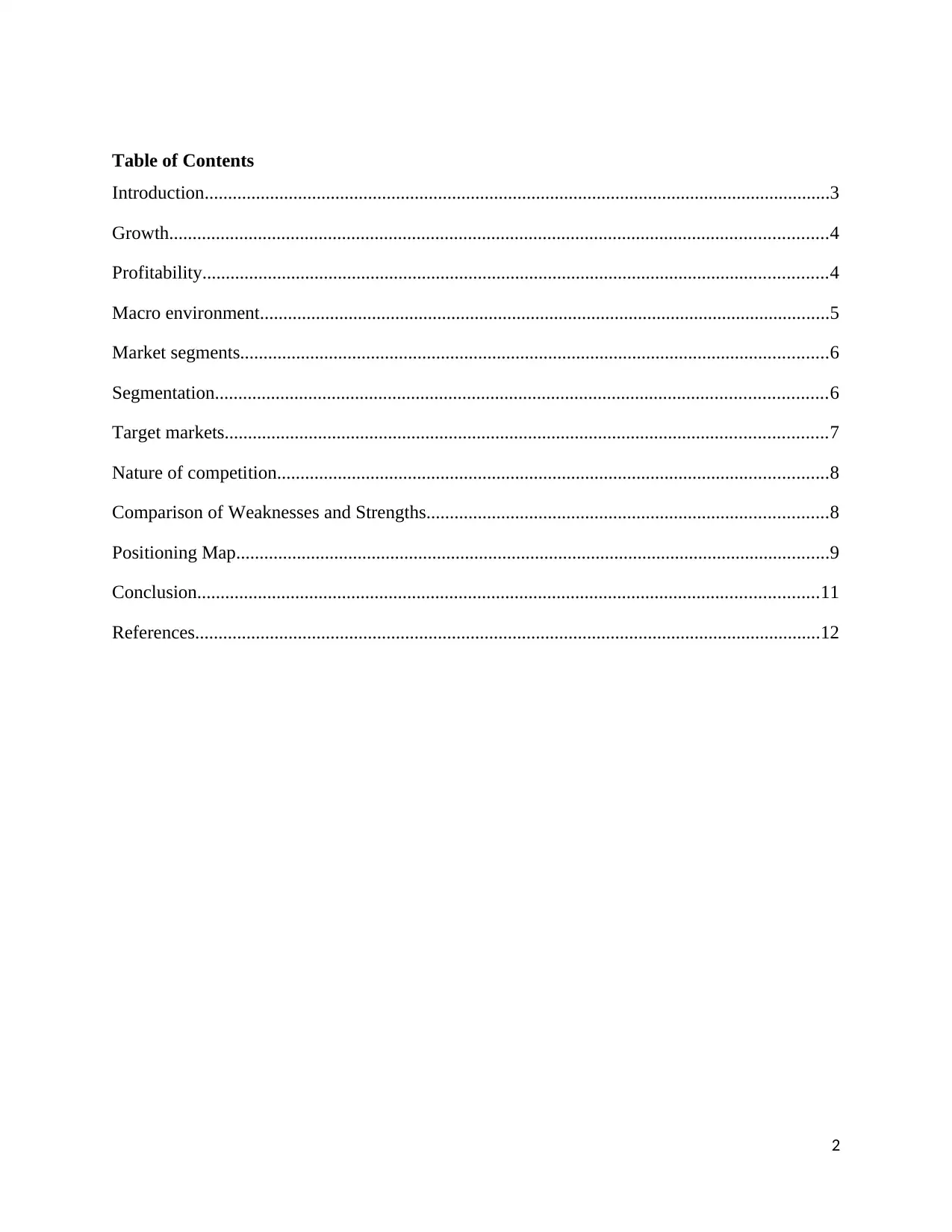
Table of Contents
Introduction......................................................................................................................................3
Growth.............................................................................................................................................4
Profitability......................................................................................................................................4
Macro environment..........................................................................................................................5
Market segments..............................................................................................................................6
Segmentation...................................................................................................................................6
Target markets.................................................................................................................................7
Nature of competition......................................................................................................................8
Comparison of Weaknesses and Strengths......................................................................................8
Positioning Map...............................................................................................................................9
Conclusion.....................................................................................................................................11
References......................................................................................................................................12
2
Introduction......................................................................................................................................3
Growth.............................................................................................................................................4
Profitability......................................................................................................................................4
Macro environment..........................................................................................................................5
Market segments..............................................................................................................................6
Segmentation...................................................................................................................................6
Target markets.................................................................................................................................7
Nature of competition......................................................................................................................8
Comparison of Weaknesses and Strengths......................................................................................8
Positioning Map...............................................................................................................................9
Conclusion.....................................................................................................................................11
References......................................................................................................................................12
2
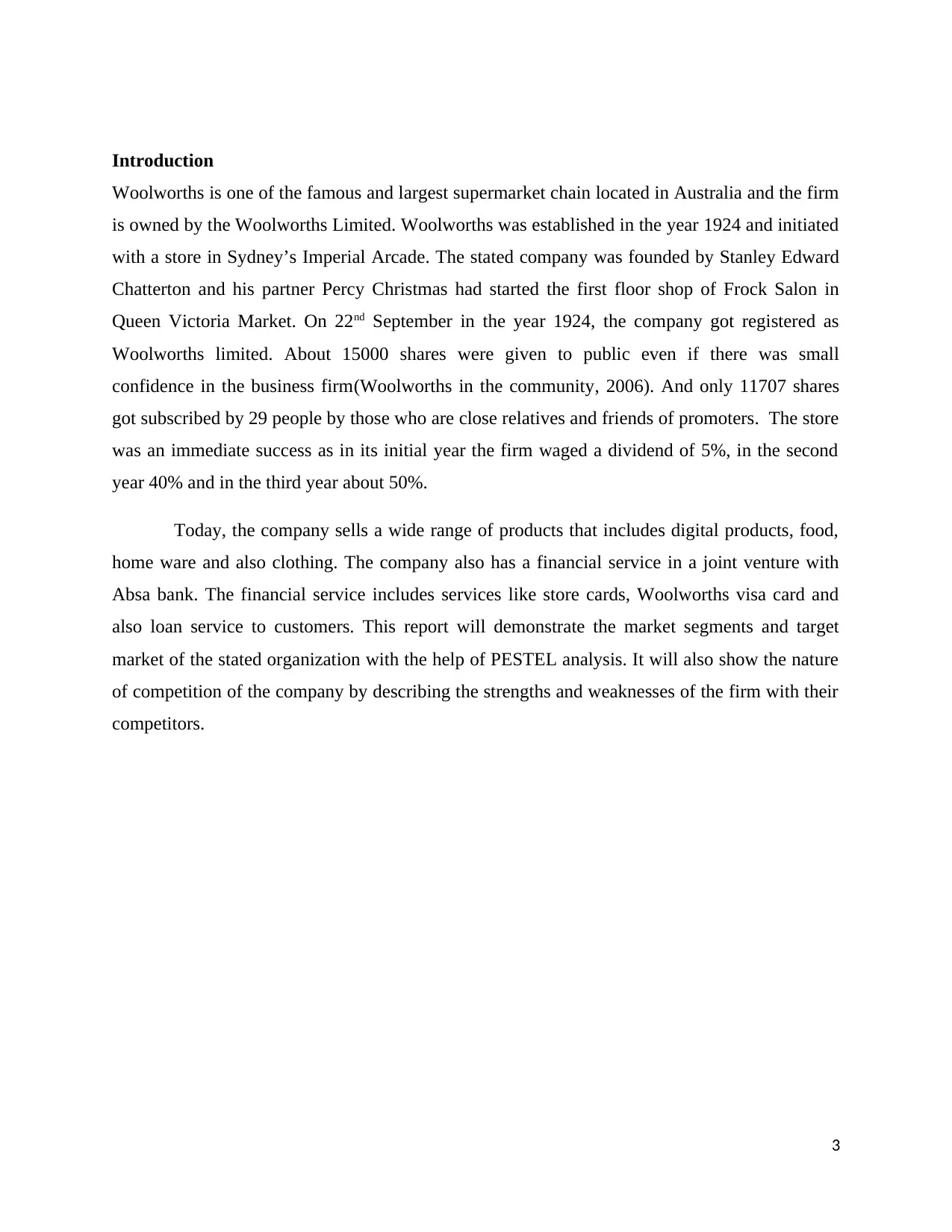
Introduction
Woolworths is one of the famous and largest supermarket chain located in Australia and the firm
is owned by the Woolworths Limited. Woolworths was established in the year 1924 and initiated
with a store in Sydney’s Imperial Arcade. The stated company was founded by Stanley Edward
Chatterton and his partner Percy Christmas had started the first floor shop of Frock Salon in
Queen Victoria Market. On 22nd September in the year 1924, the company got registered as
Woolworths limited. About 15000 shares were given to public even if there was small
confidence in the business firm(Woolworths in the community, 2006). And only 11707 shares
got subscribed by 29 people by those who are close relatives and friends of promoters. The store
was an immediate success as in its initial year the firm waged a dividend of 5%, in the second
year 40% and in the third year about 50%.
Today, the company sells a wide range of products that includes digital products, food,
home ware and also clothing. The company also has a financial service in a joint venture with
Absa bank. The financial service includes services like store cards, Woolworths visa card and
also loan service to customers. This report will demonstrate the market segments and target
market of the stated organization with the help of PESTEL analysis. It will also show the nature
of competition of the company by describing the strengths and weaknesses of the firm with their
competitors.
3
Woolworths is one of the famous and largest supermarket chain located in Australia and the firm
is owned by the Woolworths Limited. Woolworths was established in the year 1924 and initiated
with a store in Sydney’s Imperial Arcade. The stated company was founded by Stanley Edward
Chatterton and his partner Percy Christmas had started the first floor shop of Frock Salon in
Queen Victoria Market. On 22nd September in the year 1924, the company got registered as
Woolworths limited. About 15000 shares were given to public even if there was small
confidence in the business firm(Woolworths in the community, 2006). And only 11707 shares
got subscribed by 29 people by those who are close relatives and friends of promoters. The store
was an immediate success as in its initial year the firm waged a dividend of 5%, in the second
year 40% and in the third year about 50%.
Today, the company sells a wide range of products that includes digital products, food,
home ware and also clothing. The company also has a financial service in a joint venture with
Absa bank. The financial service includes services like store cards, Woolworths visa card and
also loan service to customers. This report will demonstrate the market segments and target
market of the stated organization with the help of PESTEL analysis. It will also show the nature
of competition of the company by describing the strengths and weaknesses of the firm with their
competitors.
3
⊘ This is a preview!⊘
Do you want full access?
Subscribe today to unlock all pages.

Trusted by 1+ million students worldwide
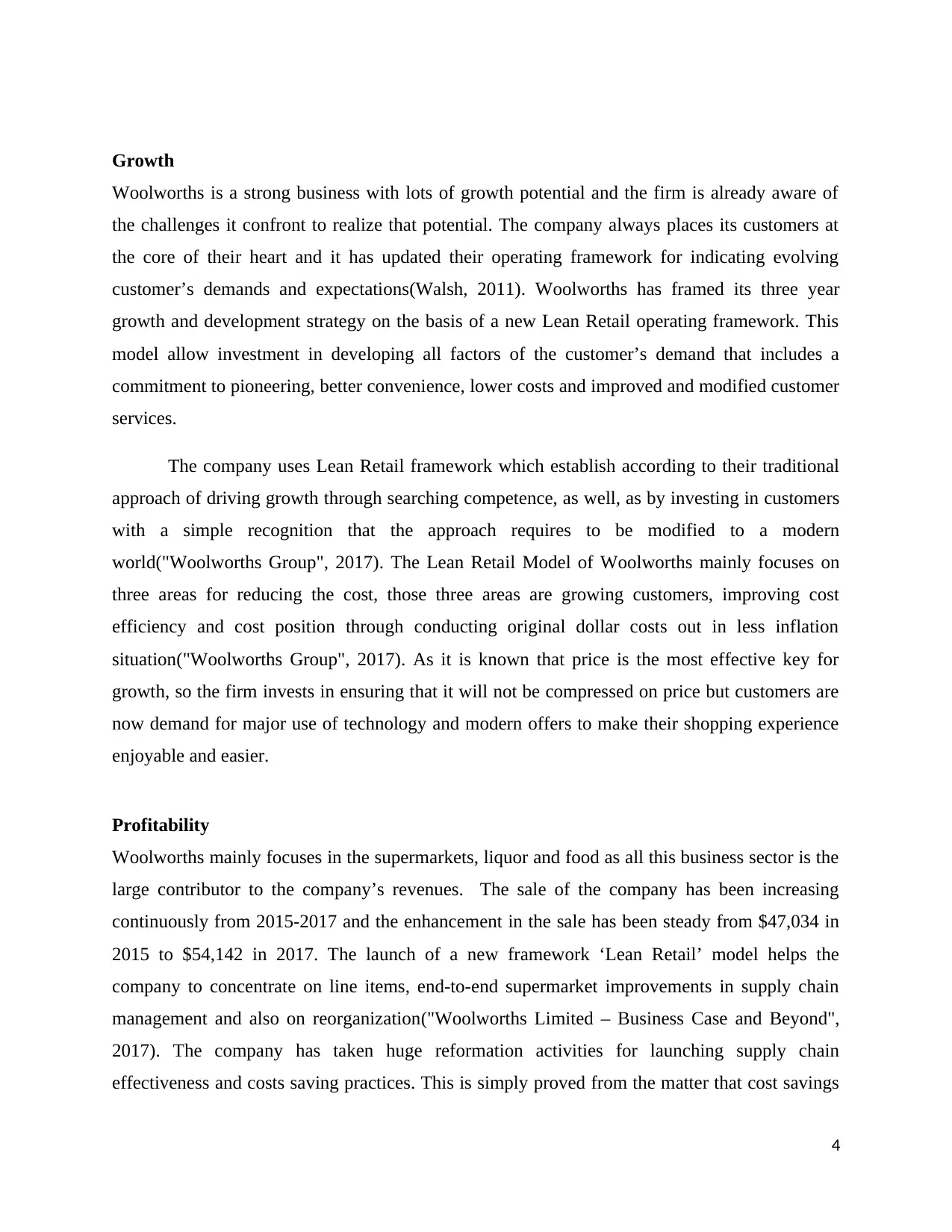
Growth
Woolworths is a strong business with lots of growth potential and the firm is already aware of
the challenges it confront to realize that potential. The company always places its customers at
the core of their heart and it has updated their operating framework for indicating evolving
customer’s demands and expectations(Walsh, 2011). Woolworths has framed its three year
growth and development strategy on the basis of a new Lean Retail operating framework. This
model allow investment in developing all factors of the customer’s demand that includes a
commitment to pioneering, better convenience, lower costs and improved and modified customer
services.
The company uses Lean Retail framework which establish according to their traditional
approach of driving growth through searching competence, as well, as by investing in customers
with a simple recognition that the approach requires to be modified to a modern
world("Woolworths Group", 2017). The Lean Retail Model of Woolworths mainly focuses on
three areas for reducing the cost, those three areas are growing customers, improving cost
efficiency and cost position through conducting original dollar costs out in less inflation
situation("Woolworths Group", 2017). As it is known that price is the most effective key for
growth, so the firm invests in ensuring that it will not be compressed on price but customers are
now demand for major use of technology and modern offers to make their shopping experience
enjoyable and easier.
Profitability
Woolworths mainly focuses in the supermarkets, liquor and food as all this business sector is the
large contributor to the company’s revenues. The sale of the company has been increasing
continuously from 2015-2017 and the enhancement in the sale has been steady from $47,034 in
2015 to $54,142 in 2017. The launch of a new framework ‘Lean Retail’ model helps the
company to concentrate on line items, end-to-end supermarket improvements in supply chain
management and also on reorganization("Woolworths Limited – Business Case and Beyond",
2017). The company has taken huge reformation activities for launching supply chain
effectiveness and costs saving practices. This is simply proved from the matter that cost savings
4
Woolworths is a strong business with lots of growth potential and the firm is already aware of
the challenges it confront to realize that potential. The company always places its customers at
the core of their heart and it has updated their operating framework for indicating evolving
customer’s demands and expectations(Walsh, 2011). Woolworths has framed its three year
growth and development strategy on the basis of a new Lean Retail operating framework. This
model allow investment in developing all factors of the customer’s demand that includes a
commitment to pioneering, better convenience, lower costs and improved and modified customer
services.
The company uses Lean Retail framework which establish according to their traditional
approach of driving growth through searching competence, as well, as by investing in customers
with a simple recognition that the approach requires to be modified to a modern
world("Woolworths Group", 2017). The Lean Retail Model of Woolworths mainly focuses on
three areas for reducing the cost, those three areas are growing customers, improving cost
efficiency and cost position through conducting original dollar costs out in less inflation
situation("Woolworths Group", 2017). As it is known that price is the most effective key for
growth, so the firm invests in ensuring that it will not be compressed on price but customers are
now demand for major use of technology and modern offers to make their shopping experience
enjoyable and easier.
Profitability
Woolworths mainly focuses in the supermarkets, liquor and food as all this business sector is the
large contributor to the company’s revenues. The sale of the company has been increasing
continuously from 2015-2017 and the enhancement in the sale has been steady from $47,034 in
2015 to $54,142 in 2017. The launch of a new framework ‘Lean Retail’ model helps the
company to concentrate on line items, end-to-end supermarket improvements in supply chain
management and also on reorganization("Woolworths Limited – Business Case and Beyond",
2017). The company has taken huge reformation activities for launching supply chain
effectiveness and costs saving practices. This is simply proved from the matter that cost savings
4
Paraphrase This Document
Need a fresh take? Get an instant paraphrase of this document with our AI Paraphraser
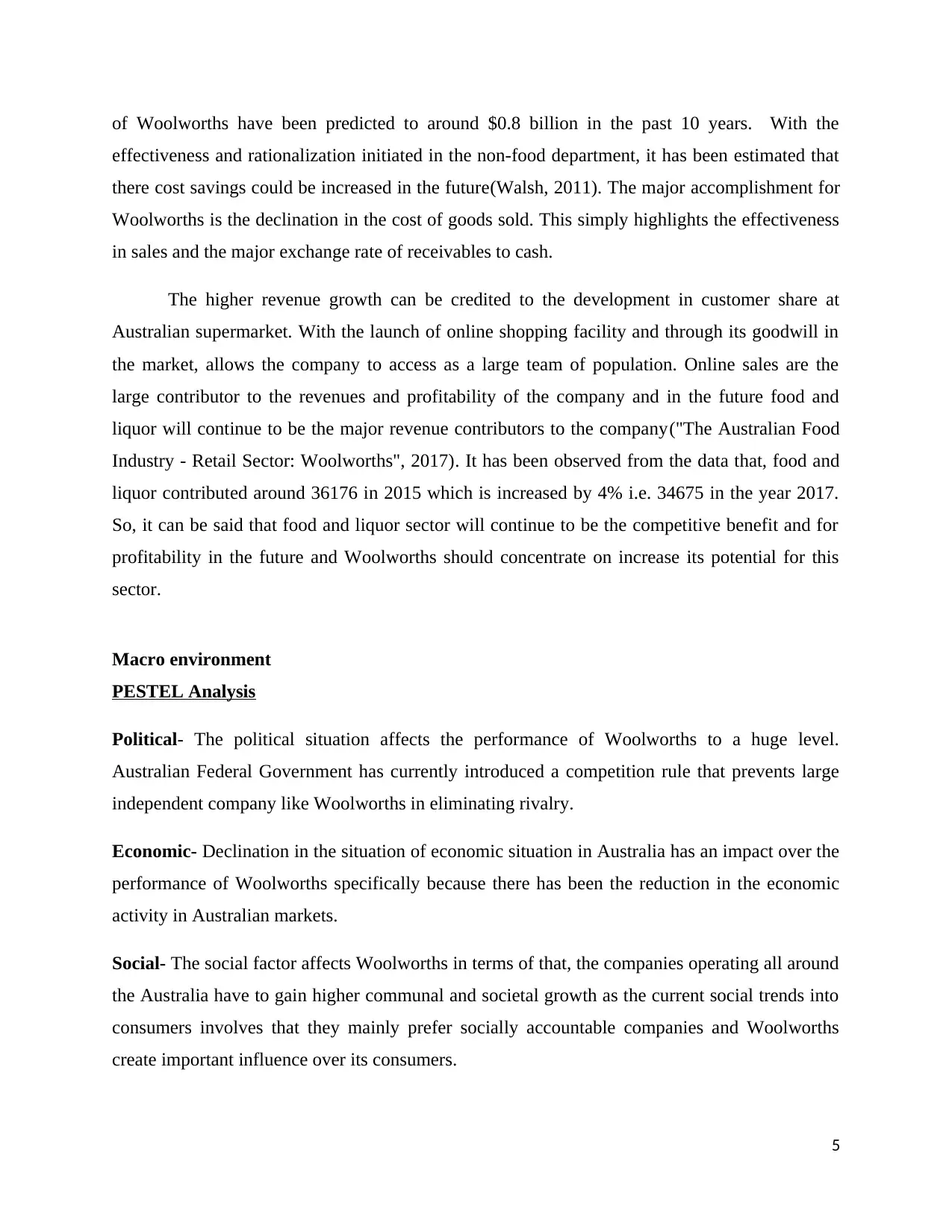
of Woolworths have been predicted to around $0.8 billion in the past 10 years. With the
effectiveness and rationalization initiated in the non-food department, it has been estimated that
there cost savings could be increased in the future(Walsh, 2011). The major accomplishment for
Woolworths is the declination in the cost of goods sold. This simply highlights the effectiveness
in sales and the major exchange rate of receivables to cash.
The higher revenue growth can be credited to the development in customer share at
Australian supermarket. With the launch of online shopping facility and through its goodwill in
the market, allows the company to access as a large team of population. Online sales are the
large contributor to the revenues and profitability of the company and in the future food and
liquor will continue to be the major revenue contributors to the company("The Australian Food
Industry - Retail Sector: Woolworths", 2017). It has been observed from the data that, food and
liquor contributed around 36176 in 2015 which is increased by 4% i.e. 34675 in the year 2017.
So, it can be said that food and liquor sector will continue to be the competitive benefit and for
profitability in the future and Woolworths should concentrate on increase its potential for this
sector.
Macro environment
PESTEL Analysis
Political- The political situation affects the performance of Woolworths to a huge level.
Australian Federal Government has currently introduced a competition rule that prevents large
independent company like Woolworths in eliminating rivalry.
Economic- Declination in the situation of economic situation in Australia has an impact over the
performance of Woolworths specifically because there has been the reduction in the economic
activity in Australian markets.
Social- The social factor affects Woolworths in terms of that, the companies operating all around
the Australia have to gain higher communal and societal growth as the current social trends into
consumers involves that they mainly prefer socially accountable companies and Woolworths
create important influence over its consumers.
5
effectiveness and rationalization initiated in the non-food department, it has been estimated that
there cost savings could be increased in the future(Walsh, 2011). The major accomplishment for
Woolworths is the declination in the cost of goods sold. This simply highlights the effectiveness
in sales and the major exchange rate of receivables to cash.
The higher revenue growth can be credited to the development in customer share at
Australian supermarket. With the launch of online shopping facility and through its goodwill in
the market, allows the company to access as a large team of population. Online sales are the
large contributor to the revenues and profitability of the company and in the future food and
liquor will continue to be the major revenue contributors to the company("The Australian Food
Industry - Retail Sector: Woolworths", 2017). It has been observed from the data that, food and
liquor contributed around 36176 in 2015 which is increased by 4% i.e. 34675 in the year 2017.
So, it can be said that food and liquor sector will continue to be the competitive benefit and for
profitability in the future and Woolworths should concentrate on increase its potential for this
sector.
Macro environment
PESTEL Analysis
Political- The political situation affects the performance of Woolworths to a huge level.
Australian Federal Government has currently introduced a competition rule that prevents large
independent company like Woolworths in eliminating rivalry.
Economic- Declination in the situation of economic situation in Australia has an impact over the
performance of Woolworths specifically because there has been the reduction in the economic
activity in Australian markets.
Social- The social factor affects Woolworths in terms of that, the companies operating all around
the Australia have to gain higher communal and societal growth as the current social trends into
consumers involves that they mainly prefer socially accountable companies and Woolworths
create important influence over its consumers.
5
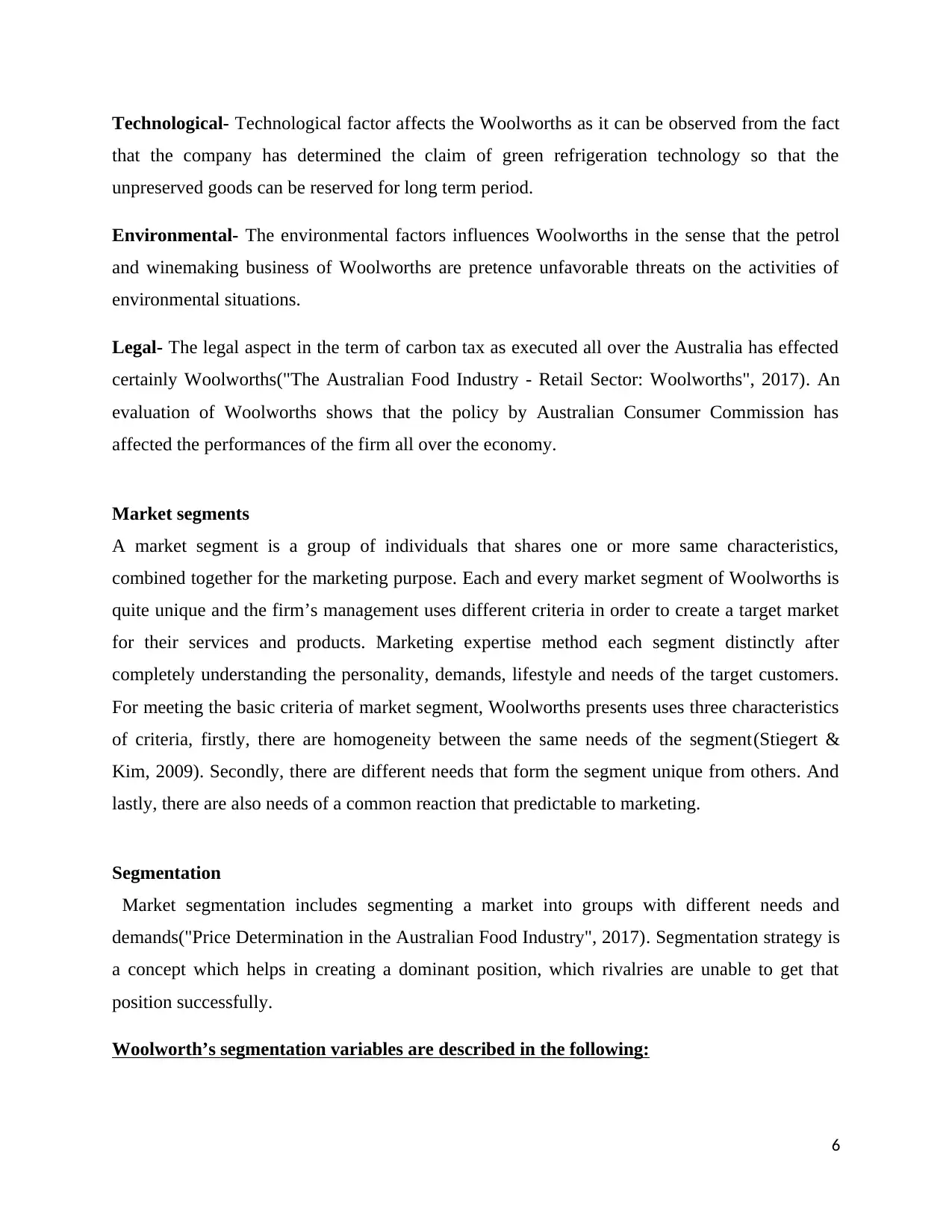
Technological- Technological factor affects the Woolworths as it can be observed from the fact
that the company has determined the claim of green refrigeration technology so that the
unpreserved goods can be reserved for long term period.
Environmental- The environmental factors influences Woolworths in the sense that the petrol
and winemaking business of Woolworths are pretence unfavorable threats on the activities of
environmental situations.
Legal- The legal aspect in the term of carbon tax as executed all over the Australia has effected
certainly Woolworths("The Australian Food Industry - Retail Sector: Woolworths", 2017). An
evaluation of Woolworths shows that the policy by Australian Consumer Commission has
affected the performances of the firm all over the economy.
Market segments
A market segment is a group of individuals that shares one or more same characteristics,
combined together for the marketing purpose. Each and every market segment of Woolworths is
quite unique and the firm’s management uses different criteria in order to create a target market
for their services and products. Marketing expertise method each segment distinctly after
completely understanding the personality, demands, lifestyle and needs of the target customers.
For meeting the basic criteria of market segment, Woolworths presents uses three characteristics
of criteria, firstly, there are homogeneity between the same needs of the segment(Stiegert &
Kim, 2009). Secondly, there are different needs that form the segment unique from others. And
lastly, there are also needs of a common reaction that predictable to marketing.
Segmentation
Market segmentation includes segmenting a market into groups with different needs and
demands("Price Determination in the Australian Food Industry", 2017). Segmentation strategy is
a concept which helps in creating a dominant position, which rivalries are unable to get that
position successfully.
Woolworth’s segmentation variables are described in the following:
6
that the company has determined the claim of green refrigeration technology so that the
unpreserved goods can be reserved for long term period.
Environmental- The environmental factors influences Woolworths in the sense that the petrol
and winemaking business of Woolworths are pretence unfavorable threats on the activities of
environmental situations.
Legal- The legal aspect in the term of carbon tax as executed all over the Australia has effected
certainly Woolworths("The Australian Food Industry - Retail Sector: Woolworths", 2017). An
evaluation of Woolworths shows that the policy by Australian Consumer Commission has
affected the performances of the firm all over the economy.
Market segments
A market segment is a group of individuals that shares one or more same characteristics,
combined together for the marketing purpose. Each and every market segment of Woolworths is
quite unique and the firm’s management uses different criteria in order to create a target market
for their services and products. Marketing expertise method each segment distinctly after
completely understanding the personality, demands, lifestyle and needs of the target customers.
For meeting the basic criteria of market segment, Woolworths presents uses three characteristics
of criteria, firstly, there are homogeneity between the same needs of the segment(Stiegert &
Kim, 2009). Secondly, there are different needs that form the segment unique from others. And
lastly, there are also needs of a common reaction that predictable to marketing.
Segmentation
Market segmentation includes segmenting a market into groups with different needs and
demands("Price Determination in the Australian Food Industry", 2017). Segmentation strategy is
a concept which helps in creating a dominant position, which rivalries are unable to get that
position successfully.
Woolworth’s segmentation variables are described in the following:
6
⊘ This is a preview!⊘
Do you want full access?
Subscribe today to unlock all pages.

Trusted by 1+ million students worldwide
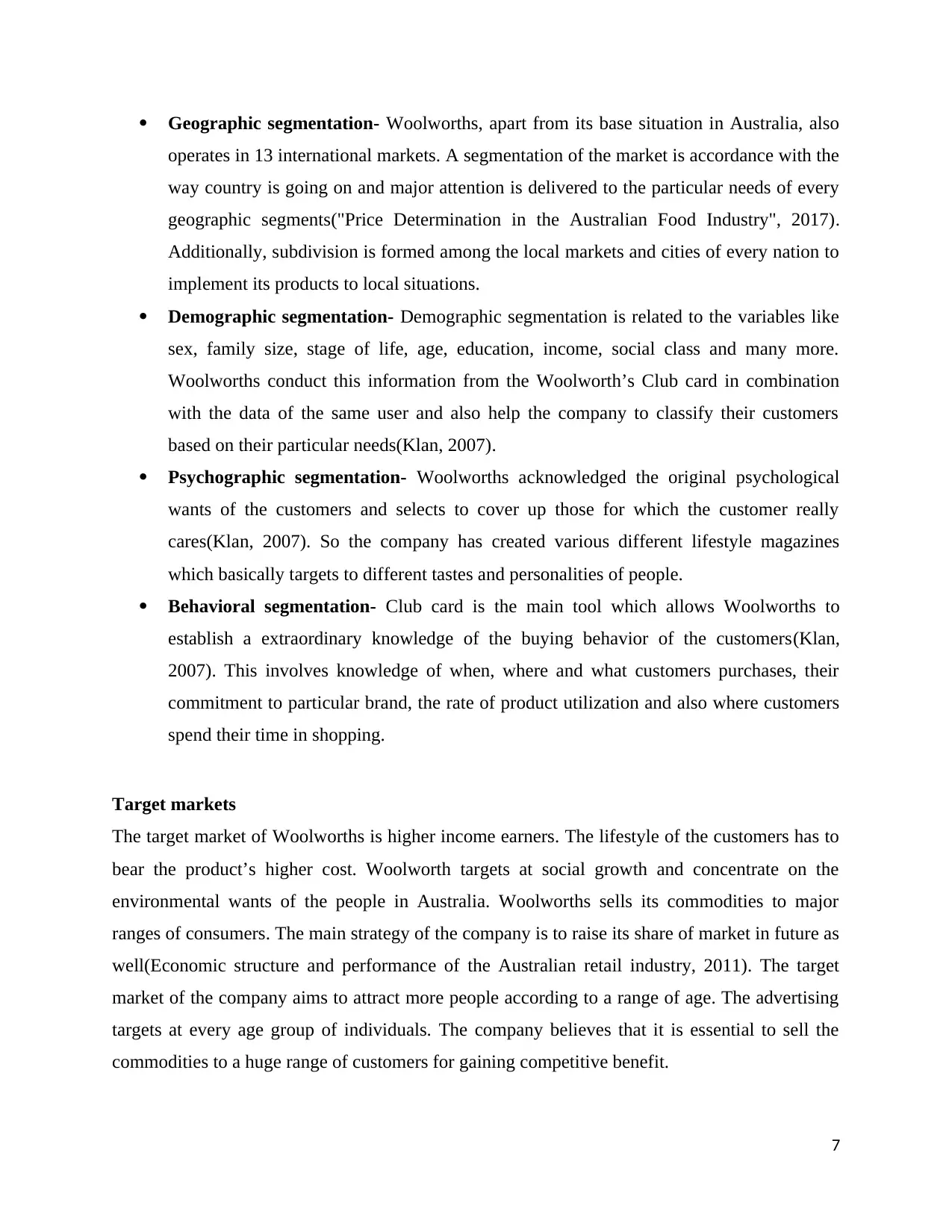
Geographic segmentation- Woolworths, apart from its base situation in Australia, also
operates in 13 international markets. A segmentation of the market is accordance with the
way country is going on and major attention is delivered to the particular needs of every
geographic segments("Price Determination in the Australian Food Industry", 2017).
Additionally, subdivision is formed among the local markets and cities of every nation to
implement its products to local situations.
Demographic segmentation- Demographic segmentation is related to the variables like
sex, family size, stage of life, age, education, income, social class and many more.
Woolworths conduct this information from the Woolworth’s Club card in combination
with the data of the same user and also help the company to classify their customers
based on their particular needs(Klan, 2007).
Psychographic segmentation- Woolworths acknowledged the original psychological
wants of the customers and selects to cover up those for which the customer really
cares(Klan, 2007). So the company has created various different lifestyle magazines
which basically targets to different tastes and personalities of people.
Behavioral segmentation- Club card is the main tool which allows Woolworths to
establish a extraordinary knowledge of the buying behavior of the customers(Klan,
2007). This involves knowledge of when, where and what customers purchases, their
commitment to particular brand, the rate of product utilization and also where customers
spend their time in shopping.
Target markets
The target market of Woolworths is higher income earners. The lifestyle of the customers has to
bear the product’s higher cost. Woolworth targets at social growth and concentrate on the
environmental wants of the people in Australia. Woolworths sells its commodities to major
ranges of consumers. The main strategy of the company is to raise its share of market in future as
well(Economic structure and performance of the Australian retail industry, 2011). The target
market of the company aims to attract more people according to a range of age. The advertising
targets at every age group of individuals. The company believes that it is essential to sell the
commodities to a huge range of customers for gaining competitive benefit.
7
operates in 13 international markets. A segmentation of the market is accordance with the
way country is going on and major attention is delivered to the particular needs of every
geographic segments("Price Determination in the Australian Food Industry", 2017).
Additionally, subdivision is formed among the local markets and cities of every nation to
implement its products to local situations.
Demographic segmentation- Demographic segmentation is related to the variables like
sex, family size, stage of life, age, education, income, social class and many more.
Woolworths conduct this information from the Woolworth’s Club card in combination
with the data of the same user and also help the company to classify their customers
based on their particular needs(Klan, 2007).
Psychographic segmentation- Woolworths acknowledged the original psychological
wants of the customers and selects to cover up those for which the customer really
cares(Klan, 2007). So the company has created various different lifestyle magazines
which basically targets to different tastes and personalities of people.
Behavioral segmentation- Club card is the main tool which allows Woolworths to
establish a extraordinary knowledge of the buying behavior of the customers(Klan,
2007). This involves knowledge of when, where and what customers purchases, their
commitment to particular brand, the rate of product utilization and also where customers
spend their time in shopping.
Target markets
The target market of Woolworths is higher income earners. The lifestyle of the customers has to
bear the product’s higher cost. Woolworth targets at social growth and concentrate on the
environmental wants of the people in Australia. Woolworths sells its commodities to major
ranges of consumers. The main strategy of the company is to raise its share of market in future as
well(Economic structure and performance of the Australian retail industry, 2011). The target
market of the company aims to attract more people according to a range of age. The advertising
targets at every age group of individuals. The company believes that it is essential to sell the
commodities to a huge range of customers for gaining competitive benefit.
7
Paraphrase This Document
Need a fresh take? Get an instant paraphrase of this document with our AI Paraphraser
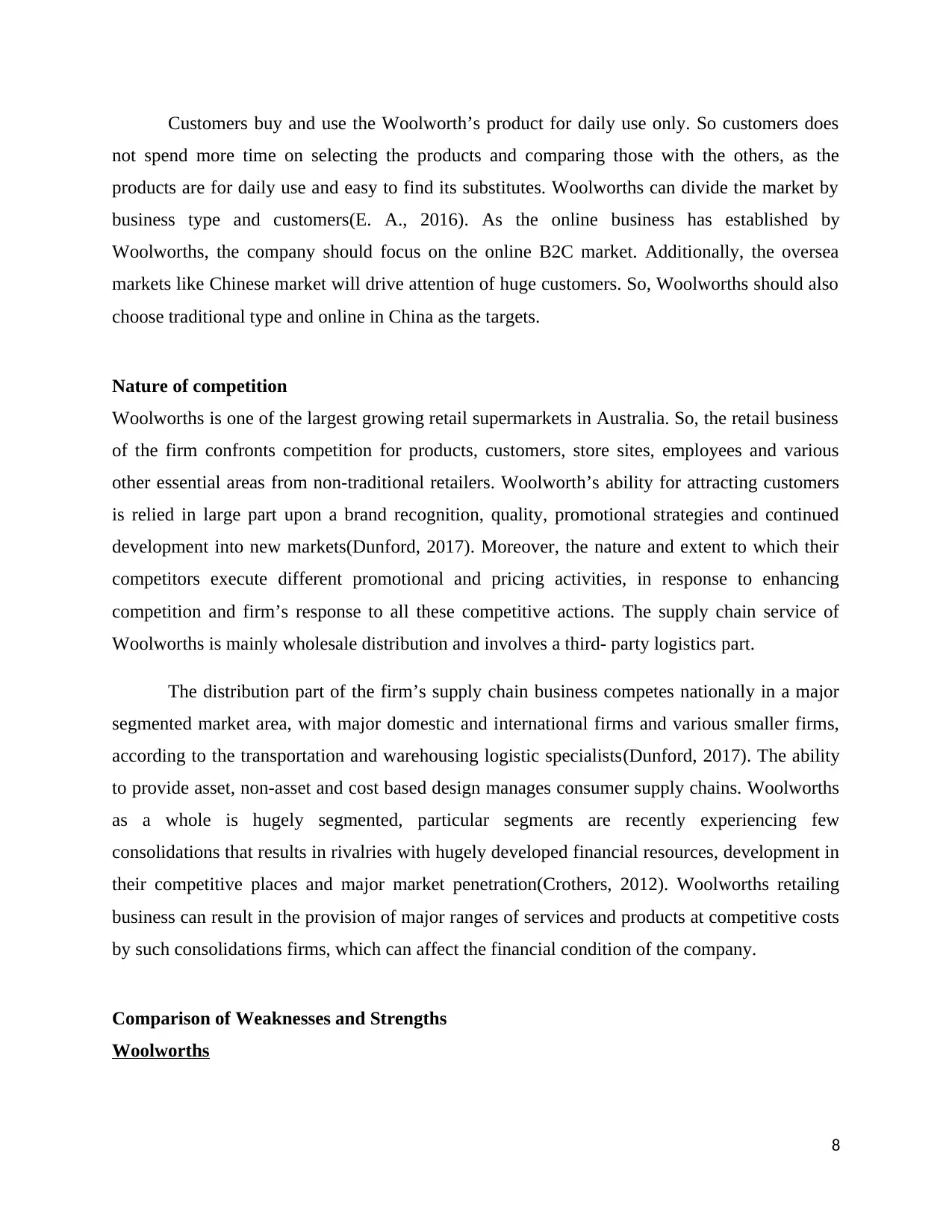
Customers buy and use the Woolworth’s product for daily use only. So customers does
not spend more time on selecting the products and comparing those with the others, as the
products are for daily use and easy to find its substitutes. Woolworths can divide the market by
business type and customers(E. A., 2016). As the online business has established by
Woolworths, the company should focus on the online B2C market. Additionally, the oversea
markets like Chinese market will drive attention of huge customers. So, Woolworths should also
choose traditional type and online in China as the targets.
Nature of competition
Woolworths is one of the largest growing retail supermarkets in Australia. So, the retail business
of the firm confronts competition for products, customers, store sites, employees and various
other essential areas from non-traditional retailers. Woolworth’s ability for attracting customers
is relied in large part upon a brand recognition, quality, promotional strategies and continued
development into new markets(Dunford, 2017). Moreover, the nature and extent to which their
competitors execute different promotional and pricing activities, in response to enhancing
competition and firm’s response to all these competitive actions. The supply chain service of
Woolworths is mainly wholesale distribution and involves a third- party logistics part.
The distribution part of the firm’s supply chain business competes nationally in a major
segmented market area, with major domestic and international firms and various smaller firms,
according to the transportation and warehousing logistic specialists(Dunford, 2017). The ability
to provide asset, non-asset and cost based design manages consumer supply chains. Woolworths
as a whole is hugely segmented, particular segments are recently experiencing few
consolidations that results in rivalries with hugely developed financial resources, development in
their competitive places and major market penetration(Crothers, 2012). Woolworths retailing
business can result in the provision of major ranges of services and products at competitive costs
by such consolidations firms, which can affect the financial condition of the company.
Comparison of Weaknesses and Strengths
Woolworths
8
not spend more time on selecting the products and comparing those with the others, as the
products are for daily use and easy to find its substitutes. Woolworths can divide the market by
business type and customers(E. A., 2016). As the online business has established by
Woolworths, the company should focus on the online B2C market. Additionally, the oversea
markets like Chinese market will drive attention of huge customers. So, Woolworths should also
choose traditional type and online in China as the targets.
Nature of competition
Woolworths is one of the largest growing retail supermarkets in Australia. So, the retail business
of the firm confronts competition for products, customers, store sites, employees and various
other essential areas from non-traditional retailers. Woolworth’s ability for attracting customers
is relied in large part upon a brand recognition, quality, promotional strategies and continued
development into new markets(Dunford, 2017). Moreover, the nature and extent to which their
competitors execute different promotional and pricing activities, in response to enhancing
competition and firm’s response to all these competitive actions. The supply chain service of
Woolworths is mainly wholesale distribution and involves a third- party logistics part.
The distribution part of the firm’s supply chain business competes nationally in a major
segmented market area, with major domestic and international firms and various smaller firms,
according to the transportation and warehousing logistic specialists(Dunford, 2017). The ability
to provide asset, non-asset and cost based design manages consumer supply chains. Woolworths
as a whole is hugely segmented, particular segments are recently experiencing few
consolidations that results in rivalries with hugely developed financial resources, development in
their competitive places and major market penetration(Crothers, 2012). Woolworths retailing
business can result in the provision of major ranges of services and products at competitive costs
by such consolidations firms, which can affect the financial condition of the company.
Comparison of Weaknesses and Strengths
Woolworths
8
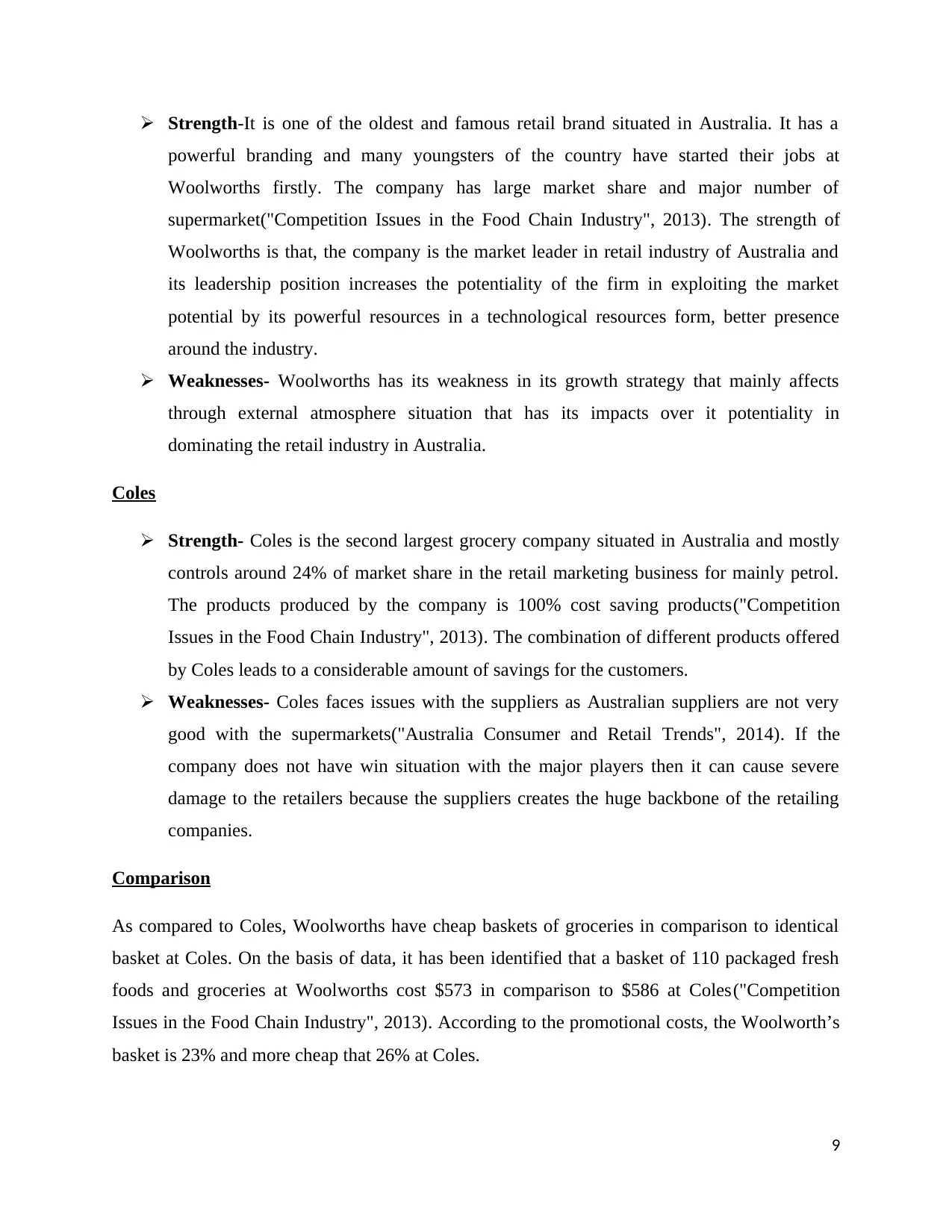
Strength-It is one of the oldest and famous retail brand situated in Australia. It has a
powerful branding and many youngsters of the country have started their jobs at
Woolworths firstly. The company has large market share and major number of
supermarket("Competition Issues in the Food Chain Industry", 2013). The strength of
Woolworths is that, the company is the market leader in retail industry of Australia and
its leadership position increases the potentiality of the firm in exploiting the market
potential by its powerful resources in a technological resources form, better presence
around the industry.
Weaknesses- Woolworths has its weakness in its growth strategy that mainly affects
through external atmosphere situation that has its impacts over it potentiality in
dominating the retail industry in Australia.
Coles
Strength- Coles is the second largest grocery company situated in Australia and mostly
controls around 24% of market share in the retail marketing business for mainly petrol.
The products produced by the company is 100% cost saving products("Competition
Issues in the Food Chain Industry", 2013). The combination of different products offered
by Coles leads to a considerable amount of savings for the customers.
Weaknesses- Coles faces issues with the suppliers as Australian suppliers are not very
good with the supermarkets("Australia Consumer and Retail Trends", 2014). If the
company does not have win situation with the major players then it can cause severe
damage to the retailers because the suppliers creates the huge backbone of the retailing
companies.
Comparison
As compared to Coles, Woolworths have cheap baskets of groceries in comparison to identical
basket at Coles. On the basis of data, it has been identified that a basket of 110 packaged fresh
foods and groceries at Woolworths cost $573 in comparison to $586 at Coles("Competition
Issues in the Food Chain Industry", 2013). According to the promotional costs, the Woolworth’s
basket is 23% and more cheap that 26% at Coles.
9
powerful branding and many youngsters of the country have started their jobs at
Woolworths firstly. The company has large market share and major number of
supermarket("Competition Issues in the Food Chain Industry", 2013). The strength of
Woolworths is that, the company is the market leader in retail industry of Australia and
its leadership position increases the potentiality of the firm in exploiting the market
potential by its powerful resources in a technological resources form, better presence
around the industry.
Weaknesses- Woolworths has its weakness in its growth strategy that mainly affects
through external atmosphere situation that has its impacts over it potentiality in
dominating the retail industry in Australia.
Coles
Strength- Coles is the second largest grocery company situated in Australia and mostly
controls around 24% of market share in the retail marketing business for mainly petrol.
The products produced by the company is 100% cost saving products("Competition
Issues in the Food Chain Industry", 2013). The combination of different products offered
by Coles leads to a considerable amount of savings for the customers.
Weaknesses- Coles faces issues with the suppliers as Australian suppliers are not very
good with the supermarkets("Australia Consumer and Retail Trends", 2014). If the
company does not have win situation with the major players then it can cause severe
damage to the retailers because the suppliers creates the huge backbone of the retailing
companies.
Comparison
As compared to Coles, Woolworths have cheap baskets of groceries in comparison to identical
basket at Coles. On the basis of data, it has been identified that a basket of 110 packaged fresh
foods and groceries at Woolworths cost $573 in comparison to $586 at Coles("Competition
Issues in the Food Chain Industry", 2013). According to the promotional costs, the Woolworth’s
basket is 23% and more cheap that 26% at Coles.
9
⊘ This is a preview!⊘
Do you want full access?
Subscribe today to unlock all pages.

Trusted by 1+ million students worldwide
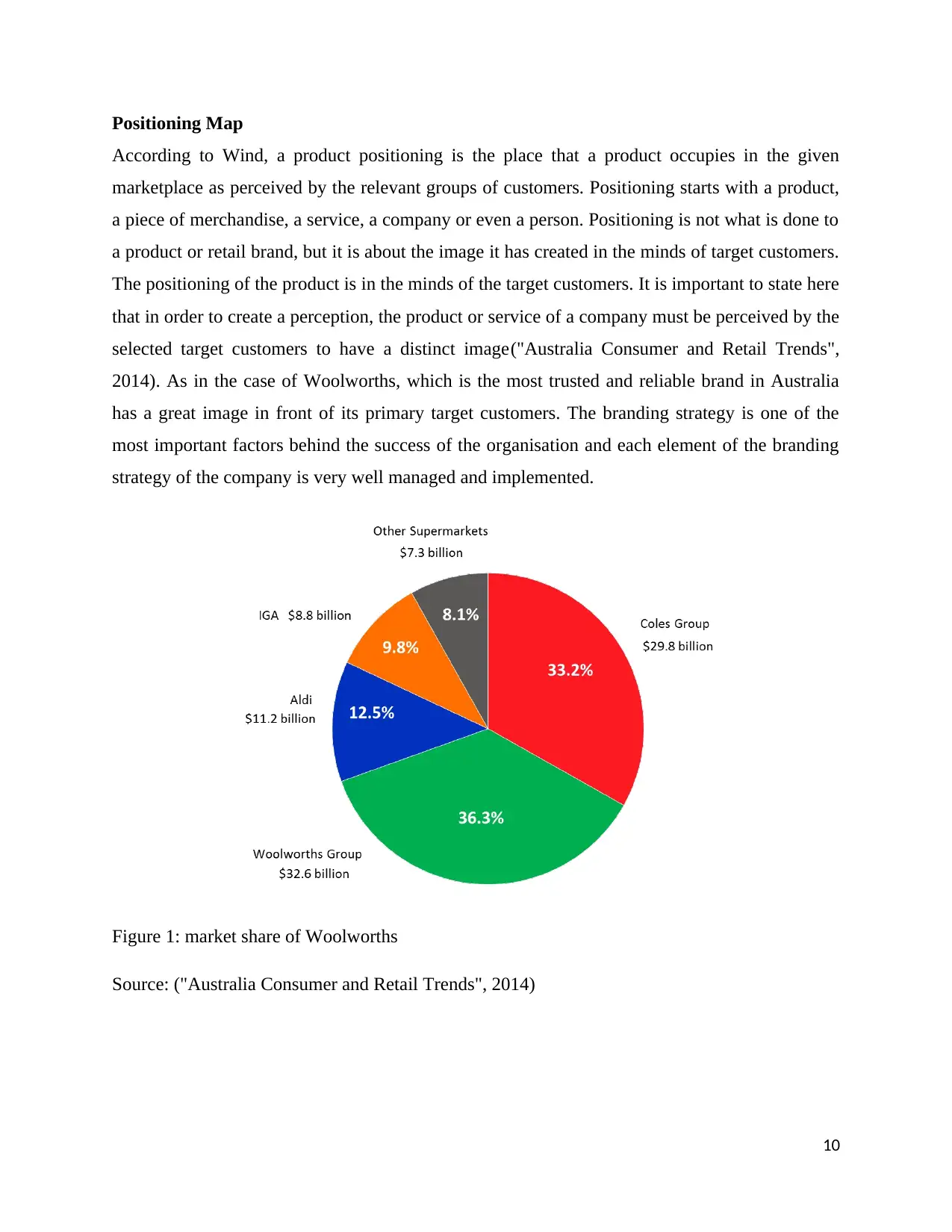
Positioning Map
According to Wind, a product positioning is the place that a product occupies in the given
marketplace as perceived by the relevant groups of customers. Positioning starts with a product,
a piece of merchandise, a service, a company or even a person. Positioning is not what is done to
a product or retail brand, but it is about the image it has created in the minds of target customers.
The positioning of the product is in the minds of the target customers. It is important to state here
that in order to create a perception, the product or service of a company must be perceived by the
selected target customers to have a distinct image("Australia Consumer and Retail Trends",
2014). As in the case of Woolworths, which is the most trusted and reliable brand in Australia
has a great image in front of its primary target customers. The branding strategy is one of the
most important factors behind the success of the organisation and each element of the branding
strategy of the company is very well managed and implemented.
Figure 1: market share of Woolworths
Source: ("Australia Consumer and Retail Trends", 2014)
10
According to Wind, a product positioning is the place that a product occupies in the given
marketplace as perceived by the relevant groups of customers. Positioning starts with a product,
a piece of merchandise, a service, a company or even a person. Positioning is not what is done to
a product or retail brand, but it is about the image it has created in the minds of target customers.
The positioning of the product is in the minds of the target customers. It is important to state here
that in order to create a perception, the product or service of a company must be perceived by the
selected target customers to have a distinct image("Australia Consumer and Retail Trends",
2014). As in the case of Woolworths, which is the most trusted and reliable brand in Australia
has a great image in front of its primary target customers. The branding strategy is one of the
most important factors behind the success of the organisation and each element of the branding
strategy of the company is very well managed and implemented.
Figure 1: market share of Woolworths
Source: ("Australia Consumer and Retail Trends", 2014)
10
Paraphrase This Document
Need a fresh take? Get an instant paraphrase of this document with our AI Paraphraser
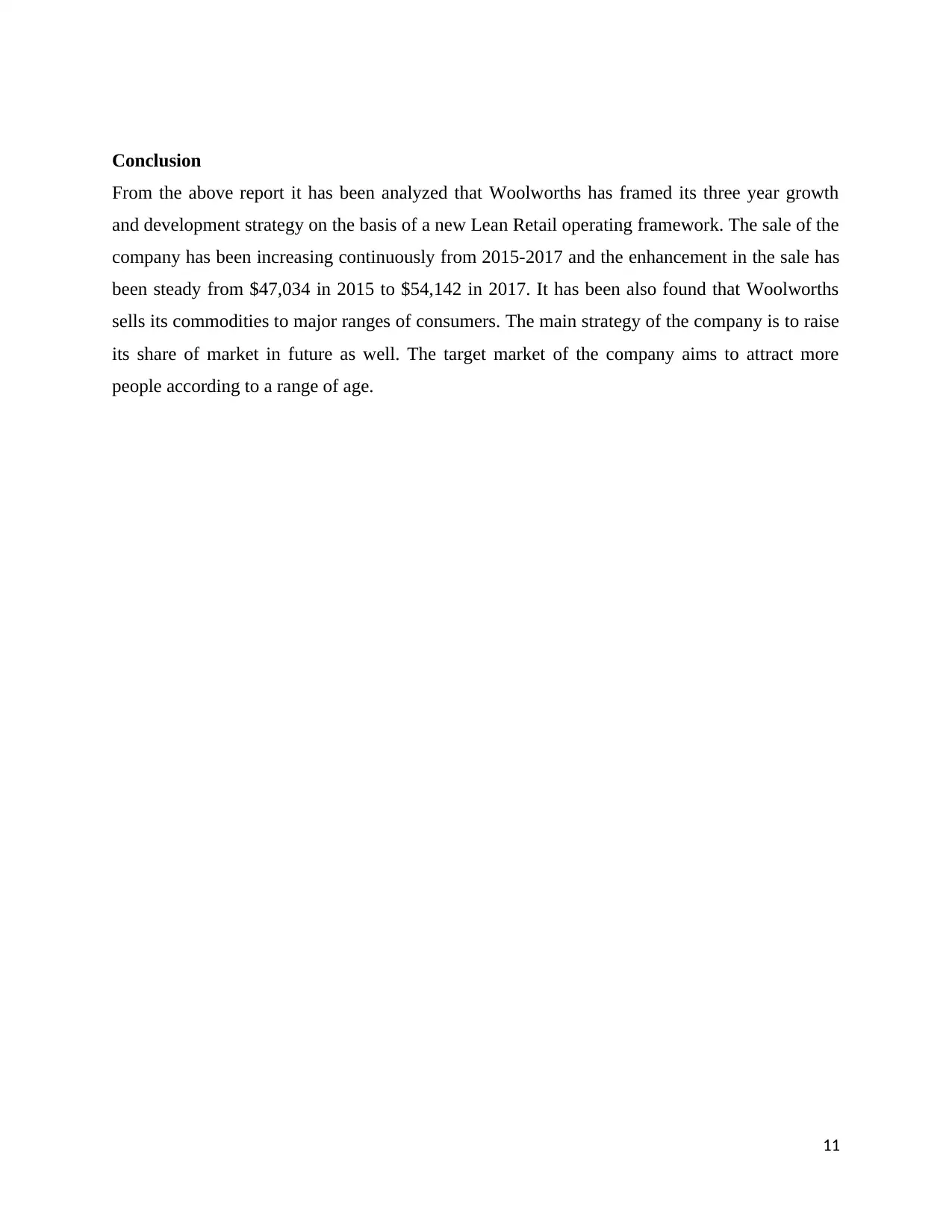
Conclusion
From the above report it has been analyzed that Woolworths has framed its three year growth
and development strategy on the basis of a new Lean Retail operating framework. The sale of the
company has been increasing continuously from 2015-2017 and the enhancement in the sale has
been steady from $47,034 in 2015 to $54,142 in 2017. It has been also found that Woolworths
sells its commodities to major ranges of consumers. The main strategy of the company is to raise
its share of market in future as well. The target market of the company aims to attract more
people according to a range of age.
11
From the above report it has been analyzed that Woolworths has framed its three year growth
and development strategy on the basis of a new Lean Retail operating framework. The sale of the
company has been increasing continuously from 2015-2017 and the enhancement in the sale has
been steady from $47,034 in 2015 to $54,142 in 2017. It has been also found that Woolworths
sells its commodities to major ranges of consumers. The main strategy of the company is to raise
its share of market in future as well. The target market of the company aims to attract more
people according to a range of age.
11
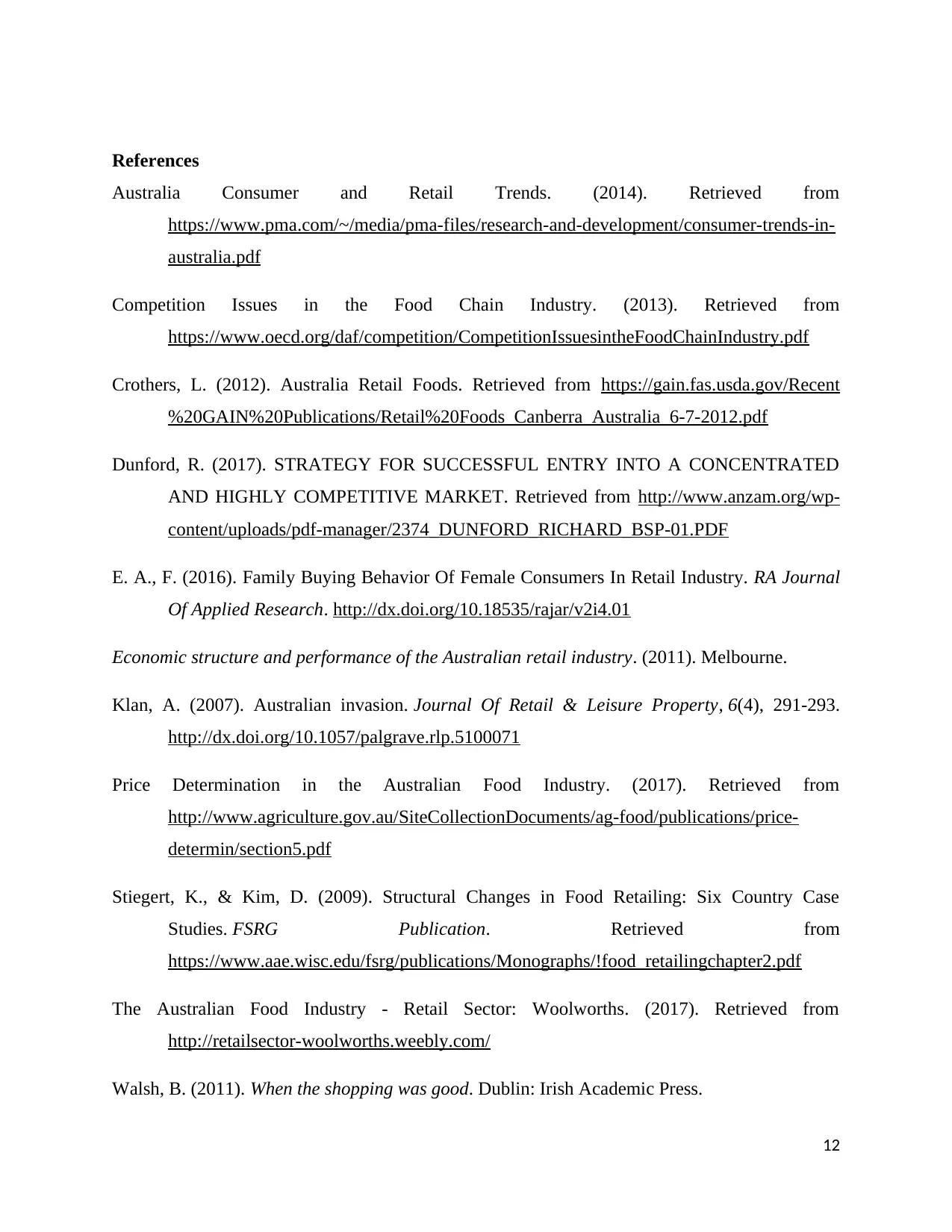
References
Australia Consumer and Retail Trends. (2014). Retrieved from
https://www.pma.com/~/media/pma-files/research-and-development/consumer-trends-in-
australia.pdf
Competition Issues in the Food Chain Industry. (2013). Retrieved from
https://www.oecd.org/daf/competition/CompetitionIssuesintheFoodChainIndustry.pdf
Crothers, L. (2012). Australia Retail Foods. Retrieved from https://gain.fas.usda.gov/Recent
%20GAIN%20Publications/Retail%20Foods_Canberra_Australia_6-7-2012.pdf
Dunford, R. (2017). STRATEGY FOR SUCCESSFUL ENTRY INTO A CONCENTRATED
AND HIGHLY COMPETITIVE MARKET. Retrieved from http://www.anzam.org/wp-
content/uploads/pdf-manager/2374_DUNFORD_RICHARD_BSP-01.PDF
E. A., F. (2016). Family Buying Behavior Of Female Consumers In Retail Industry. RA Journal
Of Applied Research. http://dx.doi.org/10.18535/rajar/v2i4.01
Economic structure and performance of the Australian retail industry. (2011). Melbourne.
Klan, A. (2007). Australian invasion. Journal Of Retail & Leisure Property, 6(4), 291-293.
http://dx.doi.org/10.1057/palgrave.rlp.5100071
Price Determination in the Australian Food Industry. (2017). Retrieved from
http://www.agriculture.gov.au/SiteCollectionDocuments/ag-food/publications/price-
determin/section5.pdf
Stiegert, K., & Kim, D. (2009). Structural Changes in Food Retailing: Six Country Case
Studies. FSRG Publication. Retrieved from
https://www.aae.wisc.edu/fsrg/publications/Monographs/!food_retailingchapter2.pdf
The Australian Food Industry - Retail Sector: Woolworths. (2017). Retrieved from
http://retailsector-woolworths.weebly.com/
Walsh, B. (2011). When the shopping was good. Dublin: Irish Academic Press.
12
Australia Consumer and Retail Trends. (2014). Retrieved from
https://www.pma.com/~/media/pma-files/research-and-development/consumer-trends-in-
australia.pdf
Competition Issues in the Food Chain Industry. (2013). Retrieved from
https://www.oecd.org/daf/competition/CompetitionIssuesintheFoodChainIndustry.pdf
Crothers, L. (2012). Australia Retail Foods. Retrieved from https://gain.fas.usda.gov/Recent
%20GAIN%20Publications/Retail%20Foods_Canberra_Australia_6-7-2012.pdf
Dunford, R. (2017). STRATEGY FOR SUCCESSFUL ENTRY INTO A CONCENTRATED
AND HIGHLY COMPETITIVE MARKET. Retrieved from http://www.anzam.org/wp-
content/uploads/pdf-manager/2374_DUNFORD_RICHARD_BSP-01.PDF
E. A., F. (2016). Family Buying Behavior Of Female Consumers In Retail Industry. RA Journal
Of Applied Research. http://dx.doi.org/10.18535/rajar/v2i4.01
Economic structure and performance of the Australian retail industry. (2011). Melbourne.
Klan, A. (2007). Australian invasion. Journal Of Retail & Leisure Property, 6(4), 291-293.
http://dx.doi.org/10.1057/palgrave.rlp.5100071
Price Determination in the Australian Food Industry. (2017). Retrieved from
http://www.agriculture.gov.au/SiteCollectionDocuments/ag-food/publications/price-
determin/section5.pdf
Stiegert, K., & Kim, D. (2009). Structural Changes in Food Retailing: Six Country Case
Studies. FSRG Publication. Retrieved from
https://www.aae.wisc.edu/fsrg/publications/Monographs/!food_retailingchapter2.pdf
The Australian Food Industry - Retail Sector: Woolworths. (2017). Retrieved from
http://retailsector-woolworths.weebly.com/
Walsh, B. (2011). When the shopping was good. Dublin: Irish Academic Press.
12
⊘ This is a preview!⊘
Do you want full access?
Subscribe today to unlock all pages.

Trusted by 1+ million students worldwide
1 out of 13
Related Documents
Your All-in-One AI-Powered Toolkit for Academic Success.
+13062052269
info@desklib.com
Available 24*7 on WhatsApp / Email
![[object Object]](/_next/static/media/star-bottom.7253800d.svg)
Unlock your academic potential
Copyright © 2020–2025 A2Z Services. All Rights Reserved. Developed and managed by ZUCOL.





